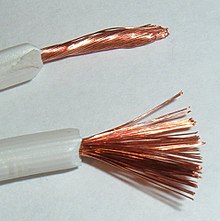Litze (electrical engineering)
The strand ( English stranded wire ) is in electrical engineering a of thin strands of existing and therefore easy to be bent electrical conductor . Copper is mainly used as a conductor. Differentiate in technical terms u. a. electrotechnical standards (e.g. IEC 60228 / VDE 0295 ) to differentiate between less flexible and highly flexible strands as “fine” or “extra fine”.
In the case of high-frequency strands (HF strands ), the individual wires are isolated from one another by a layer of lacquer, although they have the same potential. In this way, the influence of the skin effect can be reduced or avoided at high frequency - otherwise only a small part of the total cross section would participate in the current transport.
Desoldering braid is a braid soaked in flux to absorb superfluous solder using capillary action .
General
The individual wires of the strand (up to several hundred) are usually enclosed in a common insulating sheath. Such conductors are called stranded wires. If several such lines are combined in one cable, they are called cores.
Use and contact
Since the risk of a wire break due to bending is much lower with stranded cables than with solid wire conductors with the same cross-section, these are primarily used where there is frequent movement or vibration (machines, vehicles, aircraft, robots) or when a mobile device has to be supplied (electrical hand-held devices, plug-in power supply lines, microphone and loudspeaker cables). Depending on the required flexibility and degree of stress, finely or finely stranded stranded cables are used.
For connection in terminals , stranded cables usually have to be provided with wire end sleeves in order to be able to securely connect all individual wires and to protect them from mechanical damage by the clamping screw. A wire end ferrule can be dispensed with with the elevator terminal and spring-loaded terminal designs . In order to fasten the strands with screws, the end is provided with a cable lug or a cable eyelet.
Finely stranded strands assembled with cable lugs serve u. a. as so-called earth ropes of protective earthing u. a. of control cabinet doors. Overhead lines are usually also made up of several individual wires, but are not referred to as stranded wires, but rather as conductor cables .
The tinning clamped strand ends has proven to be unreliable because creep effects of the soft solder and its poor contact properties (oxidation) can lead to the loosening and interruption. There is an increased contact resistance in the terminal and thus overheating or even an arc fault with a fire hazard. On the other hand, the individual wires of strands are used to protect against oxidation and the like. a. often tin-plated or silver-plated in cables for higher operating temperatures.
See also
literature
- Hans Fischer, Jürgen Spindler, Hansgeorg Hofmann: Materials in electrical engineering: Basics - structure - properties - testing - application - technology . 6th edition. Carl Hanser Verlag, 2007, ISBN 978-3-446-40707-7 .
